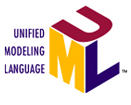


Unified modelling language (UML) is one of the most popular modelling languages in the software industry. It is used for requirements modelling in the Waterfall as well as Agile methodologies. In this UML Modelling course, we will focus on using UML diagrams for the requirements modelling.However, UML diagrams are not only used for requirements modelling but can be used for the complete software development lifecycle, from the requirements phase to the deployment phase.
The Unified Modeling Language™ is a very rich industry standard notation that can be used to define structural and behavioral constructs at various levels of abstraction, from the business level down to the implementation level.
Software practitioners have used modeling languages for decades to specify, visualize, construct, and document systems. UML which stands for The Unified Modeling Language (UML) is one of those languages and today UML is the most used standard modeling language for software and systems development. Even though not everyone need to write UML diagrams , Most software practitioners, if not all of them, need to interpret and read diagrams written by others.
UML is used to express software or system requirements, architecture, and design. After taking this course. UML will make it easy for you to communicate technical matters with other developers, analysts, designers, testers and even your clients. So it improve your ability to communicate with others and will also improve your team productivity as it will be easier to use UML to express complicated technical matters with others in much less time.
In this course, I talk about all the different UML diagrams Use cases, class diagrams, sequence diagrams, activity diagram and more. I will talk about each of them in detail. You will learn how to read and comprehend any UML diagram and you also learn the important guidelines to build them provided by subject matter experts. We will have workshops to read and build diagrams together. All these can be achieved with little effort just by watching this course.
The Unified Modeling Language (UML) has become an in-demand skill in software development and engineering. In fact, some of today’s top jobs, i.e. business analysts, enterprise architects, but also developers, technical consultants and solutions architects, require UML knowledge. Enroll today and gain knowledge in an in-demand skill that will help set you apart from the competition.
Teams adopting Agile approaches to software development could be jumping immediately from conversations to coding. The critical steps of modeling and thinking should not be skipped, because although software is delivered quickly, it is poorly architected. Unified Modeling Language (UML) has had a reputation for being document heavy, and therefore rejected. This training reverses that mindset, and shows you how UML can be an integral part of any Agile process. This is a course not just for programmers, but for all members of an Agile team looking to communicate more effectively. If you’ve experienced sprint deliverables not meeting customer expectations we can help you better communicate the key architecture and design decisions in a visual, industry standard format.
Popular courses are Code and Test Smarter with Design Patterns
If you need training for 3 or more people, you should ask us about onsite training. Putting aside the obvious location benefit, content can be customised to better meet your business objectives and more can be covered than in a public classroom. It's a cost effective option. One on one training can be delivered too, at reasonable rates.
Submit an enquiry from any page on this site, and let us know you are interested in the requirements box, or simply mention it when we contact you.
All $ prices are in USD unless it’s a NZ or AU date
SPVC = Self Paced Virtual Class
LVC = Live Virtual Class
Our clients have included prestigious national organisations such as Oxford University Press, multi-national private corporations such as JP Morgan and HSBC, as well as public sector institutions such as the Department of Defence and the Department of Health.












